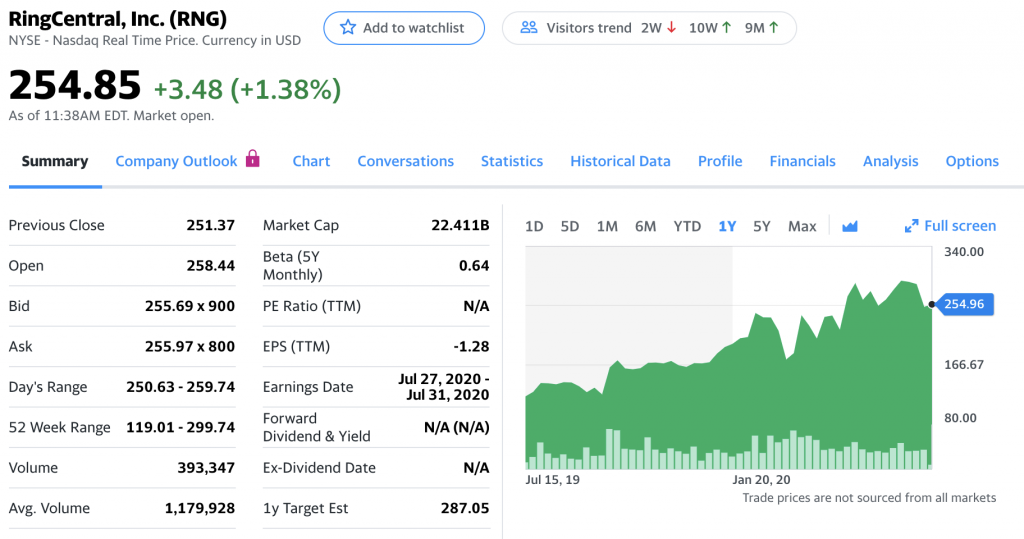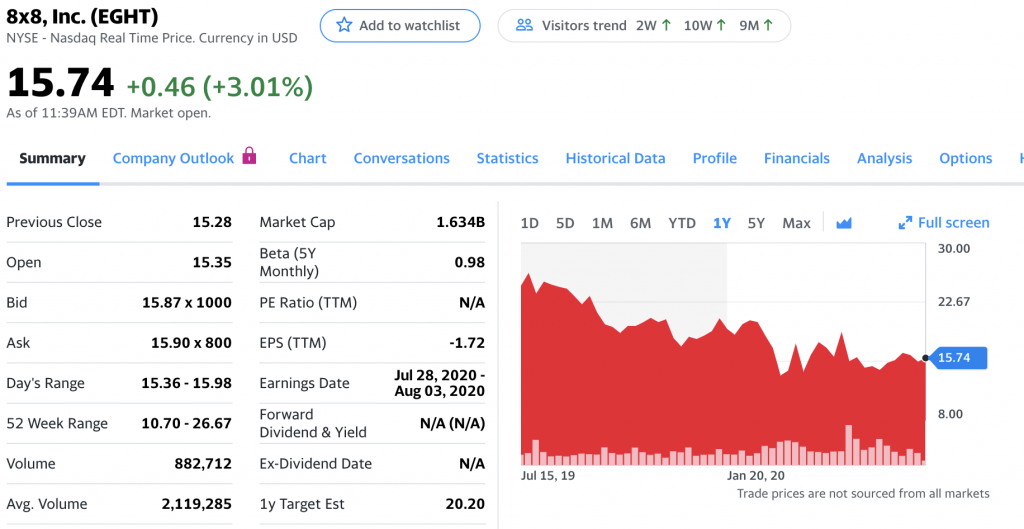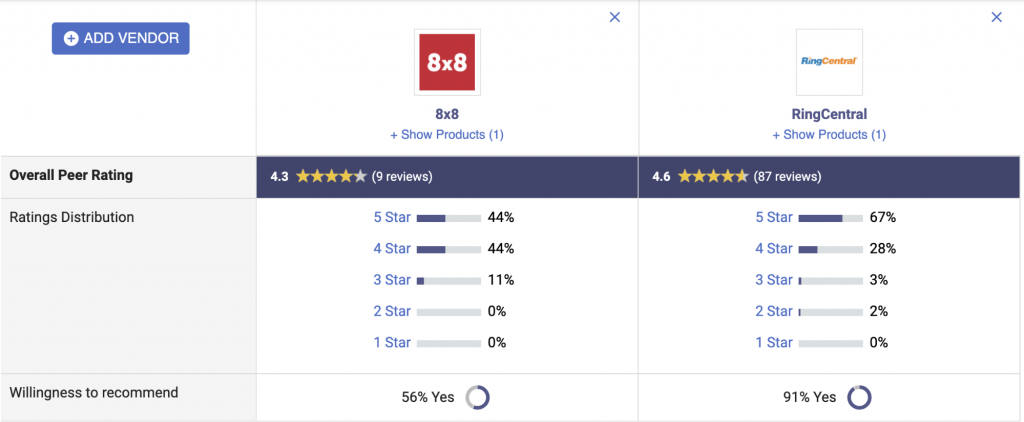While we’re confident that RingCentral is a powerful, easy-to-use solution for just about anyone in the market for a cloud-based business phone system, we know these solutions aren’t one-size-fits-all. There are a lot of similar options out there, so how do you know which one is the best fit for your small business?
It takes time to sift through all the information out there and decide who’s really delivering the best overall experience to their customers. We know this, because we’ve done the legwork for you here today, comparing RingCentral against a very close competitor: 8×8.
Here are the seven main value areas we’ll look at today in our head-to-head comparison:
- VoIP quality
- Customer support
- Outbound calling features
- Scalability
- Integrations
- Company strength
- Customer satisfaction
- As a bonus, don’t miss our reviews of some other alternatives to 8×8:
- Grasshopper
- Talkdesk
- GoToConnect
Shopping for a communication tool that has video conferencing included? (Or just curious about what you’d need to look for?) Grab the free checklist to help you choose the right one for your team or business.
8×8 vs RingCentral: A head-to-head comparison
You can read on for the nitty-gritty details, but here are our key takeaways from this comparison.
RingCentral and 8×8 are similar in some very important ways. Both products lead with a high-quality, cloud-based business phone service. According to TechRadar, RingCentral’s voice over internet protocol (VoIP) is rated #1 in the industry, and 8×8 is a ways behind at #4. Both companies also offer a fully operational contact center platform with omnichannel customer engagement. Both products include top-notch security standards and certifications and backend analytics for measuring success.
So, what’s the difference? Upfront, 8×8 stands out with a cheaper price point. They offer competitive quotes, shorter contracts, and deep discounts. It’s easy to see why all of this is appealing, especially to small businesses with tight budgets. But it’s what’s included in that lower price—and what isn’t—that sets these two companies apart. While 8×8 might win on initial costs, RingCentral delivers on long-term value.
RingCentral has been named a Leader in the Gartner Magic Quadrant for Unified Communications as a Service for multiple years in a row. Learn more!
VoIP quality
You might think that all VoIP technology is created equal. And frankly, some providers are happy to let you believe that. Why? Because it makes their sales pitch a whole lot easier. If they can keep you thinking about the bottom line, instead of the quality of service you receive for that price, they win.
What does great quality of service (QoS) look like? For starters, RingCentral is a truly global company, capable of supporting your organization no matter where you do business. We provide connectivity through a private backbone that’s independent of local providers or telco operators and offer local access numbers in countries worldwide.
8×8, by comparison, is less global in their VoIP delivery. This means your calls might be ported through a third party, depending on location and availability. This middleman can create snags in service, and it’s harder to fix something you don’t own. Should something happen with the third-party porter, this could mean downtime that 8×8 has no control over.
With RingCentral, you’ll also have access to a dashboard of QoS analytics and receive near-real-time updates to monitor your phone system’s global health. That way, you can proactively address potential problems affecting call quality and troubleshoot those issues at a granular level. As of the writing of this blog, 8×8 didn’t have a page on their site dedicated to their quality-of-service guarantees, but you can read RingCentral’s details here: “Guaranteed High Quality of Service.”
RingCentral is a PCMag’s Editors’ Choice Award winner because of its reliable service and easy-to-use app (among other reasons)!
And the quality doesn’t stop with RingCentral’s phone service. We offer high-def voice and video through our easy-to-use, work-from-anywhere app:
Customer support
As you navigate and implement new software, there’s real peace of mind in being able to reach a human being to walk you through a question or concern. If you’re a small business owner or work in IT for a small business, you know that problems don’t punch in at nine and punch out at five, and downtime can spell lost revenue.
8×8 offers a 24/7 chat bot and helpful knowledge base full of articles to help you answer your own questions, any time of day or night. They also offer a good amount of hours of live phone availability for customers with more complex issues. But when it comes to getting a real person on the phone or chat box anytime, RingCentral wins with 24/7 live support for customers with two or more users. Plus, new customers receive a single point of contact for the first 90 days of their contract who can help them with questions specific to their usage. This contact can also escalate urgent issues to the right experts as needed.
Outbound calling features
Both RingCentral and 8×8 offer predictive dialing as a standard feature in their contact centers, but that’s about where the similarities stop when it comes to outbound customer service.
RingCentral has a much richer set of features for blended customer engagement that can empower your call center reps to deliver great service and even cross-sell or upsell in the process. The user-centric platform offers easy access to customer data through agent scripting and CRM integrations across fewer screens. This means less searching and more time saved for both your company and customers at a time when customer experience is everything.
At this time, 8×8 doesn’t seem to offer agent scripting or other advanced outbound calling features for your agents or sales team.
Scalability
A platform’s ability to grow with your business can really be the difference between meeting goals or falling short. As you hunt for the right technology to improve communications, make sure you’re looking for a longer-term solution that can scale up as you do.
For instance, RingCentral offers flexibility and room to grow in both their UCaaS and CCaaS functionalities. On the UCaaS side, our audio conferencing feature is unlimited, and video conferencing can host up to 200 participants, depending on the plan you choose. 8×8 caps both audio and video conferencing at 50 people.
Plus, the RingCentral Engage Voice™ platform gives your contact center greater flexibility, scalability, and business agility while helping you save on long-term costs by not paying for unused agent logins. As of the writing of this post. 8×8’s website doesn’t seem to highlight their contact center’s ability to scale with you as you grow.
Integrations
How a new cloud phone system syncs with your existing tools is an important thing to consider as you shop. It’s always helpful to find a system that fits into place for your business like the missing piece of a puzzle, so you don’t have to waste time cobbling a new workflow together for your day.
Both RingCentral and 8×8 integrate with some of the more popular business apps out there: Salesforce, Zendesk, Outlook. But beyond this, there’s a clear winner when it comes to integrations. While 8×8 plays nice with a couple dozen applications for customer management and productivity, RingCentral integrates seamlessly with over 200 different apps (and counting!), including Slack, Asana, Zoho CRM, Google, Zapier, and many more.
🕹️ Get a hands-on look at how RingCentral works by booking a product tour:
💰 You can also use this calculator to see roughly how much your business could save by using RingCentral to support your team’s communication with each other—and clients.
8×8 vs RingCentral: Company strength
Here’s an angle you might not have considered yet in your search for new technology: how well is that tech company performing, and how positive are its perceptions in the marketplace?
Here, the numbers really speak for themselves. RingCentral is currently the largest and fastest-growing company in the VoIP market, with stock prices on a steady uptick. This has been especially true over the last year, with an impressive performance even during the current recession. On the other hand, 8×8’s stock price is much lower than RingCentral and has been trending downward over the last year:
Stock numbers surely don’t tell the whole story of a company’s financial health, but these trends seem to give at least some indication of how well each business is doing at reinvesting in their own growth. This in turn affects each company’s ability to offer the best product and keep customers and investors happy.
8×8 vs RingCentral: Customer satisfaction
If you run a small business, you know how important customer opinions are for your stability and growth. That’s why it’s a good idea to visit a reliable review site to see what real people are saying about the products you’re comparing. One of our favorites when shopping for tech solutions is Gartner, the leader in peer review for IT.
Here’s how real users feel about RingCentral and 8×8:
Not only does RingCentral have a lot more reviews than 8×8 (87 vs nine), they also have a much higher five-star rating (67% of reviewers vs 44% for 8×8). But maybe the most important score of all is a customer’s willingness to recommend. Even there, RingCentral knocks it out of the park, with a whopping 91% of reviewers saying they would recommend RingCentral. 8×8 falls well behind at 56%.
In addition to these ratings, RingCentral took the lead in another crucial area of customer experience: service. They received higher marks for both the timeliness and quality of their technical support to vendors than 8×8.
Other alternatives to 8×8
Want some more options while you shop? We get it. This is a big decision, and the more information you have, the better you’ll feel about where to spend your hard-earned money.
Check out this quick roundup of some other alternatives to 8×8 and RingCentral while you’re here to get a better idea of what’s available in the VoIP universe:
Grasshopper
The pros: Like 8×8, Grasshopper is likely to be a more affordable business phone solution on the surface, so check them out if your main concern is price. You’ll get the basic cloud communications features for this price: business phone numbers, SMS capabilities, and call and voicemail routing.
The cons: Grasshopper currently offers no third-party integrations,1 which could mean a lot of toggling between different apps. They also don’t offer a solution for your contact center at this time. Details on the breadth and depth of their features are also pretty thin on the ground, which isn’t usually the best sign. Compare their features page with RingCentral’s features page. We’ll wait here.
Talkdesk
The pros: Talkdesk is a strong customer engagement platform. They have an in-depth contact center certification program for educating new users and a wide range of international security credentials to keep businesses safe all over the world.
The cons: Talkdesk only offers workforce optimization tools for an additional price, even at their highest tier. They also don’t have a built-in feature for team collaboration (internal messaging, file sharing, and the like). Talkdesk also integrates with only a small number of third-party applications at this time and doesn’t offer omnichannel contact routing.
GoToConnect
The pros: Formerly known as Jive, GoToConnect is an offshoot of GoToMeeting, with both internal collaboration tools and a functional contact center interface with a powerful video conferencing capability.
The cons: The company touts offering 100+ features, but many of them seem pretty basic, like Caller ID and Do Not Disturb. There also isn’t much detail about any of the features offered on the website, so it’s hard to know what kind of depth or breadth they offer. We don’t see mention of analytics capabilities or any kind of metrics tracking, either: features that are pretty crucial today when it comes time to make business decisions.
Alternatives to 8×8: final thoughts
Every small business is unique; that’s what makes them so important to our economy. And we know that because of these differences, your needs are unique, even when compared to the other companies in your same industry.
If price is your most pressing concern today, 8×8 is hard to beat. They’re a solid product for getting your business phone off the ground quickly and cheaply with few frills. But there are some things that are worth paying a little extra for, in order to get the best value for your money:
- Proprietary call porting
- Scalable audio and video calls
- Scalable contact center
- Deep team collaboration functionality
- 24/7 live customer support
- 200+ third-party app integrations
- Company health
- Customer satisfaction
At the end of the day, it depends on what you’re looking for in a cloud phone service and what’s important to the needs of your small business. But in a battle, we’d put our money behind a valuable, long-term solution over a low price tag any day of the week.
If you want to do some of your own hands-on research before you buy, we highly recommend it. This is the only way you’ll be able to see firsthand how these companies interact with you and serve your individual needs. Luckily, all of these companies offer free trials of their business phone services. Book a 15-minute product tour to see how it works, or try out RingCentral for free for 15 days, and visit our competitors’ sites to take their products for a spin.
1 support.grasshopper.com/help/does-grasshopper-integrate-with-any-other-products-1048646521
Originally published Jul 20, 2020, updated Jul 16, 2024








